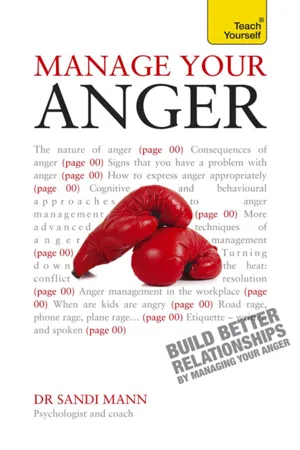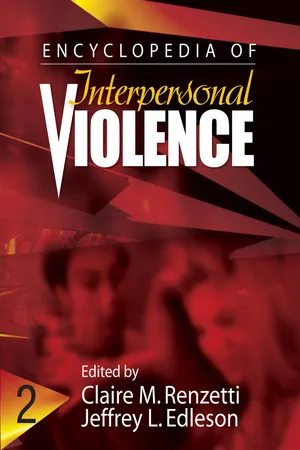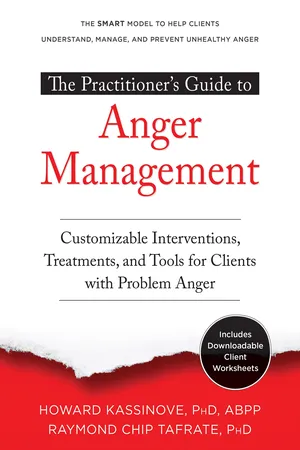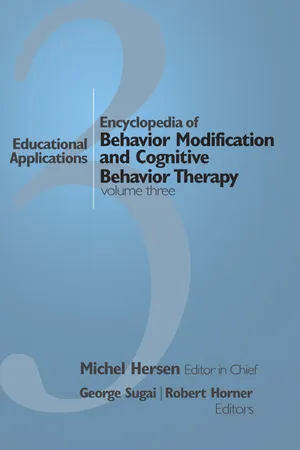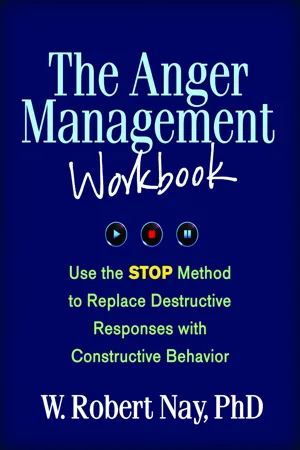Psychology
Anger Management Programmes
Anger management programs are structured interventions designed to help individuals understand and regulate their emotions, particularly anger. These programs typically involve teaching coping strategies, communication skills, and stress management techniques to help individuals effectively manage and express their anger in healthier ways. The goal is to reduce the frequency and intensity of anger outbursts and improve overall emotional well-being.
Written by Perlego with AI-assistance
Related key terms
1 of 5
8 Key excerpts on "Anger Management Programmes"
- No longer available |Learn more
- (Author)
- 2014(Publication Date)
- The English Press(Publisher)
________________________ WORLD TECHNOLOGIES ________________________ Chapter-4 Anger Management The term anger management commonly refers to a system of psychological therapeutic techniques and exercises by which someone with excessive or uncontrollable anger can control or reduce the triggers, degrees, and effects of an angered emotional state. In some countries, courses in anger management may be mandated by their legal system. One technique for controlling anger is finding agreement with another person rather than conflict. The use of deep breathing and meditation can be used as a means of relaxation. Other interventions include learning empathy, stress management skills, forgiveness, changing how you speak about yourself or others and improving optimism. As the issue of anger varies from person to person, the treatments are designed to be personal to the individual. Methods of anger management Psychologists recommend a balanced approach to anger, which both controls the emotion and allows the emotion to express itself in a healthy way. Some descriptions of actions of anger management are: • Direct This would include making behavior visible and making communication clear. The end result is to not become resentful, but rather, be honest about the feeling of anger and what is causing it. • Honorable This includes identifying the moral basis for the anger, and being willing to dialog around the reason for the anger. In short, this includes taking responsibility for actions. • Focused This means staying with the issue of concern, and not bringing up irrelevant material. • Courageous This implies careful and thoughtful self-examination. Additionally, this means being willing to admit when one is wrong or when a reaction is inappropriate. • Humility This means seeking the truth instead of merely being defensive, and self-justifying. - eBook - ePub
- Sandi Mann(Author)
- 2012(Publication Date)
- Teach Yourself(Publisher)
What happens if it is not appropriate to get angry – but you still feel furious? This chapter considers ways to help you simmer down when you are either getting too angry about a particular situation (and expressing excessive anger) or angry when it is not appropriate to do so (such as when someone won’t do what you want). As mentioned repeatedly throughout this book, anger management is not about learning to suppress anger or to try to stop feeling angry; it is about getting angry when it is appropriate to do so and expressing that anger in an appropriate manner.Cognitive and behavioural approaches to anger management involve both the mental processes (our thoughts) and behavioural processes (what we do). We have already discussed in chapter 3 some of these approaches in relation to the ‘angry personality’ but here we will look at some specific cognitive and behavioural techniques aimed at controlling our anger when we know we need to cool it – but just can’t.These techniques include: • avoiding the provocation • distancing yourself from the provocation • disrupting your anger response • taking physical exercise.
Anger management techniques can involve changing our mental processing, our actual behaviour, or both. Avoiding the provocationPoint to remember Previously (in chapters 2 and 3 ), we have discussed the avoidance response in reference to a strategy that contributes to the angry personality, so it is important here to distinguish between avoidance as a maladaptive (i.e. negative) anger management strategy (as discussed in chapters 2 and 3 ) and avoidance as an adaptive (or positive) strategy, as we will see here. The maladaptive avoidance is when the individual avoids dealing with anger – or withdraws from the situation – whereas the strategy to be discussed here is when the individual avoids (or minimizes their exposure to) the provocation or the anger-eliciting event. Avoiding dealing with the anger arousal can be negative and contribute to the angry personality as explained previously, but avoiding the anger-eliciting event can be a positive and helpful strategy.In chapter 1 we started to chart those ‘anger triggers’ that cause anger – and to put them into common themes. You will probably notice a recurrence of the sorts of things that make you angry. For many of us, there is a pattern to the things that typically make us angry. For example, a poll carried out by the TV Channel GOLD to mark the 30th anniversary of the hit sitcom Fawlty Towers - eBook - PDF
- Claire M. Renzetti, Jeffrey L. Edleson, Claire M. Renzetti, Jeffrey L. Edleson(Authors)
- 2008(Publication Date)
- SAGE Publications, Inc(Publisher)
Anger becomes a problem when it is expressed inappropriately through aggression or becomes a state of chronic hostility. Aggression is usually defined as behavior that interferes with the rights of others, and it can include emotional, sym-bolic, and physical abuse. Aggression is distinguished from assertiveness, which is the constructive expression of feelings and personal rights. Methods of anger management usually include the following: (a) relax-ation to reduce physiological arousal related to anger; (b) problem solving to find rational alternatives to aggression; (c) cognitive restructuring to uncover the thoughts that lead to anger and to create constructive thoughts that reduce anger; (d) recognition of physio-logical cues that are early warning signs of extreme anger; and (e) time-out to remove oneself from a situ-ation in which one’s anger is escalating. Anger can also sometimes be reduced when it is recognized that hurt or fear underlie it and are being masked by anger. Anger management has been used to prevent the occurrence or recurrence of family violence, includ-ing child abuse, elder abuse, and domestic violence, often under the heading of “cognitive therapy” or “stress management.” There are several reasons why it is controversial when applied to domestic violence. Edward Gondolf and David Russell were probably the first of many authors to critique anger management for men who batter. - eBook - PDF
Offending Behaviour Programmes
Development, Application and Controversies
- Emma J. Palmer, Clive R. Hollin(Authors)
- 2006(Publication Date)
- Wiley(Publisher)
According to Edwards et al. (2001) the actual methods of intervention are an eclectic mix of “Evidence-based assessment and intervention strategies . . . (e.g., behavior therapy, cognitive behavior therapy, pragmatic family therapies)” (p. 111), and both the young person and caregivers may be taught strategies for behaviour change. Programmes for Adults Adult programmes have mainly been delivered in institutions, with all of their attendant challenges to therapeutic integrity and change (see Chapter 7). These programmes vary widely and three examples will be given below. For a prison pro-gramme to succeed, effectively addressing institutional challenges to programme implementation and management is as important as sound programme content. Serin & Preston (2001a) discuss the importance of appropriate site selection, staff selection and training, and programme marketing to referrers and offenders. They and others have noted the likely costs to therapy effectiveness of conflict between 138 OFFENDING BEHAVIOUR PROGRAMMES system factions in which the therapy is embedded (Gaes, 2001 ; Quinsey, Harris, Rice & Cormier, 1998). Anger Management A number of manualised programmes exist, most commonly based on Novaco’s approach (Novaco, 1997). For example, in the 1980s the New Z ealand Depart-ment of Justice developed the Video Anger Management Programme (VAMP) from Novaco’s SIT approach. This 10-session programme teaches participants de fi n-itions of anger and violence, how to recognise their own anger, and to identify its developmental antecedents. Other elements include time out and relaxation train-ing, recognising anger-inducing thinking, coping self-talk for provoking events, assertiveness, conflict resolution, and relationship skills (Howells et al., 2001). The most important application issue with such stand-alone programmes con-cerns participant selection. - eBook - PDF
- Tafrate, Raymond Chip, Kassinove, Howard(Authors)
- 2019(Publication Date)
- Impact(Publisher)
28 The Practitioner’s Guide to Anger Management As also noted in the introduction, clients have their own preferences and expecta- tions regarding treatment, which may lead them to consider some interventions accept- able and others unacceptable. For example, a client may accept a relaxation procedure but bristle at the idea of forgiving a perceived enemy. Some clients want to incorporate religious teachings into their progress, whereas others reject any kind of spiritual compo- nent. These factors all argue for the development of customizable programming—and that is what you will develop as a SMART anger manager. Elements That Lead to Change Our recommendations regarding the multiple elements that lead to anger reduction are based on current thinking in the fields of counseling and psychotherapy. For example, Johnsen and Friborg (2015, 748), cite four sources of improvement that are associated with efficacious treatment in psychotherapy research trials: 1. Client-related factors: These include the client’s personality traits, tempera- ment, motivation for treatment, and experience of significant life events. 2. Therapist-related factors: These include the practitioner’s education, training, skill level, knowledge of interventions, and competence in engaging the client and establishing the therapeutic alliance as well as such personal factors as gender, age, and even height and appearance. 3. Common factors: These include factors important across all models of psycho- therapy, such as the context of therapy, the presence of an acceptable rationale for the interventions to be used, the achieved client-practitioner relationship, expectations for improvement, and perceived social support. - eBook - PDF
Helping Schoolchildren Cope with Anger
A Cognitive-Behavioral Intervention
- Jim Larson, John E. Lochman(Authors)
- 2010(Publication Date)
- The Guilford Press(Publisher)
25 CHAPTER 3 The Role of Anger Management Training in a Comprehensive School Program of Positive Behavioral Supports This is a book about helping children manage anger-fueled aggressive and disruptive behav- ior through the use of small-group or individual cognitive-behavioral skills training. There is a percentage of children in every school building for whom the traditional disciplinary system is, in large measure, ineffective. To the adults in charge, these are students who appear to be aware of the rules of conduct but who are seemingly unable (or, in fewer cases, unwilling) to adhere to them. They defy adult compliance requests, sometimes with angry retorts or tantrums. • They argue, push, and fight on the playground, in the hallways, and in the cafeteria. • They disrupt classroom cooperative learning groups and are routinely feared and • rejected by peers. As a consequence, these students take up a disproportionate amount of teachers’ and administrators’ time. They become subjected to a punishment-oriented school disciplinary system that is ill designed to meet their needs (Kaufman, 2005) and that becomes increas- ingly exclusionary over time (Skiba & Peterson, 2000). The traditional school disciplinary system is typically organized to respond to problem behavior with aversive consequences— a phone call home, a stern lecture by the administrator, after-school detention, in-house suspension, and the like. This system is built on the proposition that most children who engage in problem behavior actually know how to behave appropriately but, through acci- dent or design, have chosen not to and therefore deserve a mild punitive consequence to help remind them in the future. Portions of this chapter were adapted from Larson (2005). Copyright 2005 by The Guilford Press. Adapted by per- mission. - eBook - PDF
Encyclopedia of Behavior Modification and Cognitive Behavior Therapy
Volume I: Adult Clinical Applications Volume II: Child Clinical Applications Volume III: Educational Applications
- Michel Hersen(Author)
- 2005(Publication Date)
- SAGE Publications, Inc(Publisher)
Many of the cognitive restructuring strategies are trans- formed into games, to which the adolescents seem to be quite receptive. Role play with coaching helps them to practice these improved cognitive responses. They are able to learn how to solve problems and to develop nonhostile attributions in response to hypo- thetical conflict situations. Repeated practice once the “package” of skills has been taught is necessary not only to reinforce the newly acquired responses but also to help the adolescent make appropriate social judg- ments in response to the triggering event, to maximize successful outcome. Anger management groups usually consist of six to eight adolescents between the ages of 14 and 18. Ideally, the group should be facilitated by two thera- pists, who can model a social interaction in a role play. The program consists of a minimum of 10 sessions. If it is implemented in a residential facility, the sessions may be held as frequently as deemed necessary. In a nonresidential setting, one or two sessions a week are recommended. RESEARCH BASIS Research has shown that anger control training results in specific behavioral changes in children and adolescents, 654———Adolescent Anger Management assessed via self-report and changes in cognitions. However, few of the published anger control studies have produced directly observable and reliably recorded change in actual rates and intensities of aggressive behavior. Most studies are too brief to adequately assess maintenance. The following data are offered to show the relative effectiveness of implementation versus nonimplemen- tation of the anger management program. A field study testing the effectiveness of the pro- gram on antisocial behaviors of adolescents in a run- away shelter showed a decrease in antisocial behavior compared with pretreatment weeks. Interestingly, there was a greater decrease for females residing at the shelter. They represented 54% of the total sample of 522 adolescents. - eBook - PDF
The Anger Management Workbook
Use the STOP Method to Replace Destructive Responses with Constructive Behavior
- W. Robert Nay(Author)
- 2014(Publication Date)
- The Guilford Press(Publisher)
93 Part II Managing Your Anger and Resolving Conflict At this point you’ve learned that every anger response has biological, cognitive, and behav- ioral components. You’ve had a chance to see how your own body and mind react when anger is triggered and what faces of anger you display through your behavior. Based on this understanding, you can begin to formulate an effective strategy for managing anger, which is the goal of this second part of the book. Having a coherent anger management strategy that you can count on when provocative situations arise requires that you: 1. Be aware of your body, mind, and actions so that you can detect when anger arousal has begun. You can’t possibly manage something if you’re not aware that it is occurring. 2. Identify your level of anger arousal. Your ability to think and act calmly and rationally deteriorates rapidly as your level of arousal escalates, so you need a way to measure or “scale” your anger so you know how and when you must stop your anger from advancing any further. 3. Use tools that will help you curtail and reduce (“dampen”) anger arousal. Quickly interrupting your anger early on makes it possible to exercise calm control and rational thinking so you can discern what you need to do to solve the problem you face. 4. Identify and challenge expectations, interpretations, self-instructions, and pro- vocative mental images that fuel anger arousal. Only by identifying unhelpful thoughts and immediately rebutting and replacing them with objective and helpful thinking can you turn off the cascade of anger arousal and solve the problem you face. You can also challenge the well-learned unhelpful beliefs that your thoughts rest on, changing your reaction to the provocative situation for good so that anger may no longer be triggered at all. 94 MANAGING YOUR ANGER AND RESOLVING CONFLICT 5. Problem-solve a plan that sets the stage for solving the problem you face.
Index pages curate the most relevant extracts from our library of academic textbooks. They’ve been created using an in-house natural language model (NLM), each adding context and meaning to key research topics.

